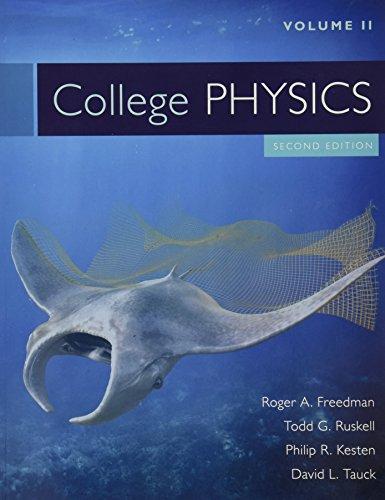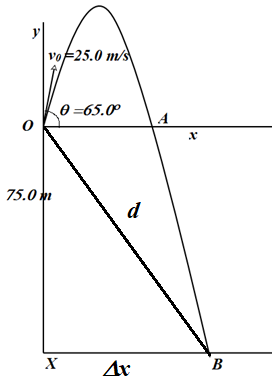
Concept explainers
(a)
How long after throwing the rock, it returns to its original height.
Answer to Problem 67QAP
The rock returns to its original height 4.62 s after it was thrown.
Explanation of Solution
Given:
Speed of the rock
Angle of projection of the rock
Formula used:
The equation of motion for the vertical motion of the rock can be used to determine the time it would take for it to return to the height at which it was projected.
Here,
Calculation:
The rock is projected from point O, where the origin of the chosen coordinate system rests. The x axis is drawn parallel to the ground and the + y axis points vertically upwards. The rock moves under the action of the gravitational force. The acceleration acting on the rock acts downwards and it is equal to the acceleration of free fall.
The rock moves upwards and reaches the point of maximum height and then descends down to point A, which is at the same height as the point O.
This is shown in the diagram below:

The total vertical displacement made by the rock when it reaches point A is equal to zero.
Therefore,
Calculate the vertical component of the rock's velocity.
Substitute 0 m for
Conclusion:
Thus, the rock returns to its original height 4.62 s after it was thrown.
(b)
When the stone projected from the top of the dam would hit the water flowing out of the dam.
Answer to Problem 67QAP
The stone would hit the water after 6.86 s after it was thrown and the sound of splash would reach us 0.303 s later.
Explanation of Solution
Given:
Height of the dam from the ground
Speed of the rock
Angle of projection of the rock
Speed of sound in air
Formula used:
The equation for the vertical motion of the rock is
Here,
The equation for the horizontal motion of the rock is
Here,
The time taken by sound to reach the point of projection is given by,
Here, d is the total distance traveled by sound with a speed
Calculation:
The vertical component of the rock's velocity, calculated in part (a) is
The total vertical displacement made by the rock when it reaches the water is equal to the height of the dam.
In equation (1), substitute
Rearrange the equation.
Solve for t.
Taking the positive root,
The stone splashes into water at point B, which is at a horizontal distance

No force acts on the rock in the horizontal direction, hence the acceleration
Calculate the horizontal component of the rock's velocity.
Substitute 10.56 m/s for
The sound of splash starts from point B and travels along BO to reach the point of projection.
Calculate the distance travelled by sound.
Calculate the time taken by the sound of splash to reach the point of projection using equation (3).
Conclusion:
Thus, the stone would hit the water after 6.86 s after it was thrown and the sound of splash would reach us 0.303 s later
Want to see more full solutions like this?
Chapter 3 Solutions
College Physics Volume 2
- A football quarterback is moving straight backward at a speed of 2.00 m/s when he throws a pass to a player 18.0 m straight downfield. The ball is thrown at an angle of 25.0° relative to the ground and is caught at the same height as it is released. What is the initial velocity of the ball relative to the quarterback?arrow_forwardA dive-bomber has a velocity or 280 m/s at ail angle below the horizontal. When the altitude of the aircraft is 2.15 km, it releases a bomb, which subsequently hits a target on the ground. The magnitude of the displacement from the point of release of the bomb to the target is 3.25 km. Find the angle .arrow_forwardA jogger jogs two blocks directly north. (a) How do the joggers average speed and the magnitude of the average velocity compare? (b) If the joggers return trip follows the same path, then how do average speed and magnitude of the average velocity compare for the total trip?arrow_forward
- Repeat the problem above, but reverse the order of the two legs of the walk; show that you get the same final result. That is, you first walk leg B, which is 20.0 m in a direction exactly 40° south of west, and then leg A, which is 12.0 m in a direction exactly 20° west of north. (This problem shows that A+B=B+A .)arrow_forwardSuppose a soccer player kicks the ball from a distance 30 m toward the goal. Find the initial speed of the ball if it just passes over the goal, 2.4 m above the ground, given the initial direction to be 40° above the horizontal.arrow_forwardA projectile is launched with speed v0 at an angle 0 above the horizon. Its motion is described in terms of position, velocity, and acceleration: x, y, vx, vy, ax, ay, respectively, (a) Which of those quantities are constant during the motion? (b) Which are equal to zero throughout the motion? Ignore any effects of air resistance.arrow_forward
- A car is parked on a cliff overlooking the ocean on an incline that makes an angle of 24.0 below the horizontal. The negligent driver leaves the car in neutral, and the emergency brakes are defective. The car rolls from rest down the incline with a constant acceleration of 4.00 m/s2 for a distance of 50.0 m to the edge of the cliff, which is 30.0 m above the ocean. Find (a) the cars position relative to the base of the cliff when the car lands in the ocean and (b) the length of time the car is in the air.arrow_forwardIs it possible for speed to be constant while acceleration is not zero? Give an example of such a situation.arrow_forwardA celebrated Mark Twain story has motivated contestants in the Calaveras County Jumping Frog Jubilee, where frog jumps as long as 2.2 m have been recorded. If a frog jumps 2.2 m and the launch angle is 45, find (a) the frogs launch speed and (b) the time the frog spends in the air. Ignore air resistance.arrow_forward
- A quarterback can run with a speed of vq = 15 mph. He throws a ball with a speed of vb = 35 mph at some unknown angle θ between 30 and 60 degrees, which is measured from horizontal. Neglect air resistance. - a reciever runs past the quarteback ( just beside him) at speed vq. If the quarterback releases his pass at that instant what would be the angle in degrees that he would have to throw the ball for the reciever to catch it?arrow_forwardA basketball player shoots when he is 5m away from the backboard. If the ring is 3m high, the basketball player is 2.1m tall and if the distance from the backboard to the ring is 425mm. Determine the initial velocity of the player if it is released in at an angle of 30° with the horizontal.arrow_forwardEXAMPLE 2-9 THE FERRY DOCKSA ferry makes a short run between two docks: one in Anacortes, Washington, the other on Guemes Island. As the ferryapproaches the Guemes dock (traveling in the positive x direction), its speed is 6.8 m>s. (a) If the ferry slows to a stop in13.3 s, what is its average acceleration? (b) As the ferry returns to the Anacortes dock, its speed is 6.1 m>s. If it comes torest in 12.9 s, what is its average acceleration?arrow_forward
 College PhysicsPhysicsISBN:9781938168000Author:Paul Peter Urone, Roger HinrichsPublisher:OpenStax College
College PhysicsPhysicsISBN:9781938168000Author:Paul Peter Urone, Roger HinrichsPublisher:OpenStax College College PhysicsPhysicsISBN:9781305952300Author:Raymond A. Serway, Chris VuillePublisher:Cengage Learning
College PhysicsPhysicsISBN:9781305952300Author:Raymond A. Serway, Chris VuillePublisher:Cengage Learning College PhysicsPhysicsISBN:9781285737027Author:Raymond A. Serway, Chris VuillePublisher:Cengage Learning
College PhysicsPhysicsISBN:9781285737027Author:Raymond A. Serway, Chris VuillePublisher:Cengage Learning An Introduction to Physical SciencePhysicsISBN:9781305079137Author:James Shipman, Jerry D. Wilson, Charles A. Higgins, Omar TorresPublisher:Cengage Learning
An Introduction to Physical SciencePhysicsISBN:9781305079137Author:James Shipman, Jerry D. Wilson, Charles A. Higgins, Omar TorresPublisher:Cengage Learning Physics for Scientists and Engineers, Technology ...PhysicsISBN:9781305116399Author:Raymond A. Serway, John W. JewettPublisher:Cengage Learning
Physics for Scientists and Engineers, Technology ...PhysicsISBN:9781305116399Author:Raymond A. Serway, John W. JewettPublisher:Cengage Learning




